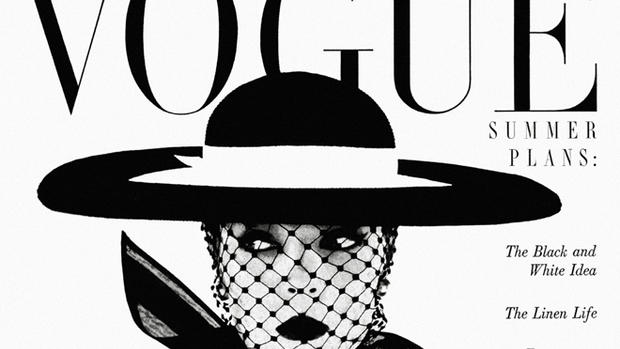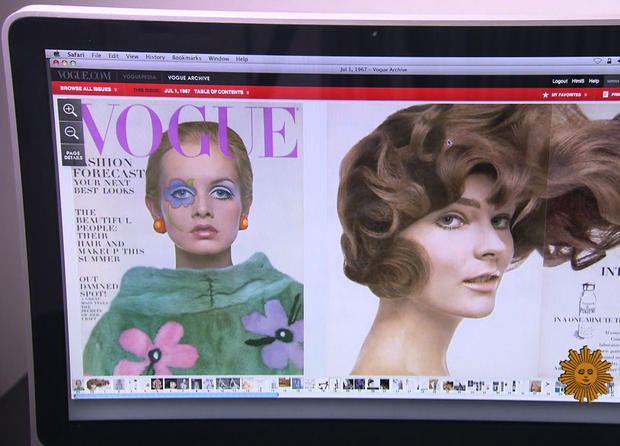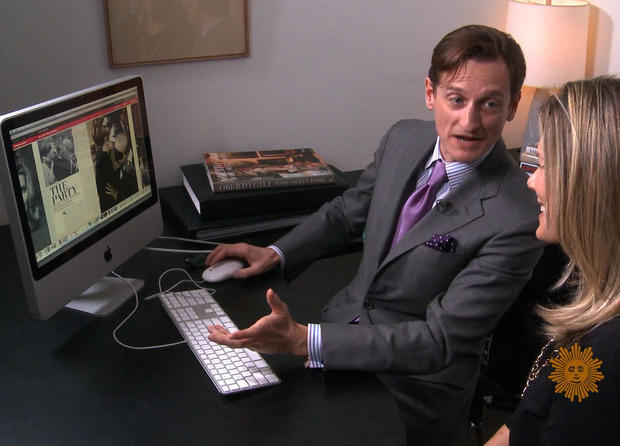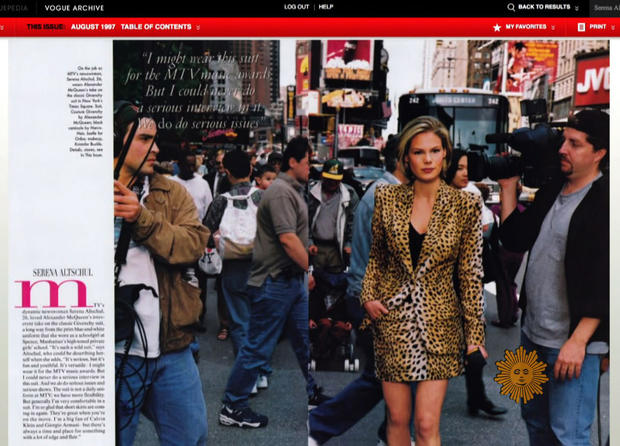Vogue puts its 120-year history online
It's a major birthday for a publishing institution that has kept generations up-to-date on what fashions are IN VOGUE. With Serena Altschul this morning, we'll look back:
It's known as fashion's Bible - Vogue magazine, where the elite and the aspiring alike turn for the style of the moment, and the past.
And nothing may mean more in fashion than landing on the cover of Vogue.
"To be in Vogue has to mean something," said Anna Wintour, who has been Vogue's editor-in-chief for 23 years. "It's an endorsement. It's a validation. "
With her signature bob haircut and dark sunglasses, Wintour is considered the most powerful figure in fashion.
When asked what a good cover should do, Wintour replied, "A cover's a poster. It has to look like Vogue. It has to be a strong image. It has to be seductive."
"Can being on the cover of Vogue change a model's career?" asked Altschul.
"It certainly will make everybody take notice of you in a way that they haven't before."
Now the magazine is taking note of its famous covers for its 120th anniversary in 2012.
Wintour, contributor Dodie Kazanjian and international editor-at-large Hamish Bowles have compiled a book of the magazine's most famous covers.
Started as a weekly magazine for high society New Yorkers, early Vogue covers featured well-polished young women known as "Gibson girls," named after the illustrator who created the look.
"A Vogue cover really holds a mirror up to its time," said Bowles.
In 1909, publishing big shot Conde Nast bought Vogue, and used the cover to reach a wider upscale audience.
"Suddenly you see a totally different atmosphere," said Bowles. "You have this explosion of color for a start - really wonderful world-class illustrators start to produce covers which become kind of abstract and fanciful, and certainly aspirational."
Art deco and the jazz age inspired covers in the coming years, but the real change came in 1932 with the first color photo cover by photography pioneer Edward Steichen.
Since then, legendary photographers like Cecil Beaton, Irving Penn and Annie Liebovitz have shot the most famous cover in the fashion.
"I like to think they all have the Vogue stamp, but I don't like the idea of them all looking identical," Wintour said.
By the '70s and '80s, many covers had come to look identical. It was time for a change.
So when the British-born mother of two took over American Vogue in 1988 after running the U.K. version, Wintour turned the fashion world upside-down . . . starting with her very first cover.
"It was totally unplanned," she said.
Wintour used an image never intended for the cover, featuring an Israeli model wearing jeans.
"And I just said, 'Well, let's just try this.' And off we went. It was just very natural. To me it just said, 'This is something new. This is something different.' And I remember the printers called us up because they thought we'd made a mistake - just wanting to check that that actually WAS the cover!"
"It was really radical," said Bowles. "In every way, it broke every kind of prescribed boundary and rule that had existed up 'til then."
Wintour continued to push boundaries by putting celebrities on the cover instead of supermodels - a revolutionary move at the time.
"I remember getting quite a bit of criticism for my first Madonna cover - you know, 'She's not in vogue, she'll never sell,'" recalled Wintour. "It was a little bit risky."
But sales on newsstands shot up, Wintour said. "Something extraordinary, like 40 percent. So that was an eye-opener to all of us."
"But you knew something? Or you just followed your instinct?" asked Altschul.
"I didn't know anything," Wintour said. "I never pay any attention. I'm sure it's not such a good way to be, but I don't really follow market research. And in the end I do respond to my own instincts. Sometimes they're successful, and obviously sometimes they're not. But you have to, I think, remain true to what you believe in."
In the 120 years of Vogue, maybe no issue has sold better than the 100th anniversary issue in 1992, featuring the supermodels who had graced so many covers.
"They were kind of the Liz Taylors of the '80s," Wintour said. "They were the ones with the unbelievably glamorous lives and the crazy glamorous boyfriends. And they were the girls that everyone wanted to be."
If everyone wanted to be the supermodels, everyone IN fashion wants Vogue's September issue, the massive look at fall's must-haves.
"The September issue is kind of the best-of-the-best," remarked Bowles.
A documentary followed the making of 2007's magazine - the largest in Vogue history, with 840 pages and weighing five pounds.
"Oh my gosh, so who can put this in their purse? I mean, really, it's so big," said Altschul.
"Well, that brings us to the online archive," said Bowles.
This past Wednesday, Vogue unveiled its new digital archive. Every single page - covers, ads and all - from all nearly 120 years of the magazine are now online.
"If you look through the archives, you'll see that always Vogue has had access to our world and to other worlds in a way that no other has ever had," Wintour said. "A great fashion picture obviously reflects the time just as much as The New York Times headline does. And I think that's what the archives really will show."
Wintour says looking at the archive, people can see the world through a different set of eyes:
"It's a very different experience, actually, looking at the collections through the eyes of the Vogue editors as opposed to seeing it live, through video or paparazzi pictures or whatever it may be," she said.
Viewable through this keyhole into history is Truman Capote's Black and White Ball.
For now, anyone can pay the $1,500 to use it, but soon Vogue magazine subscribers will have access to part of the archive including that first issue from 1892.
"So the beauty of this is that when you and I were looking at the hard copy, we could barely touch it," said Altschul. "We couldn't open it and here we are inside looking at every page, all the details and the illustrations are crisp."
The archive is a treasure trove for both fashion historians and those just nostalgic for the past.
The 400,000 pages are indexed to allow users to search what any model was wearing while snapped by a certain photographer - such as Kate Moss wearing Marc Jacobs, shot by Annie Liebovitz.
And you never know what else might turn up ... such as typing in "Serena Altschul." A photo taken in Times Square by Annie Liebowitz. "That was such a fun one."
And while Vogue magazine is celebrating its past, it's also looking forward . . . setting the standard to new styles, trends, and of course, next month's cover.
After all, Wintour says with a laugh, "It's always the NEXT issue that's gonna be the best one!"
For more info:
- vogue.com
- Vogue Archive
- "Vogue: The Covers" by Dodie Kazanjian and Hamish Bowles (Abrams)



